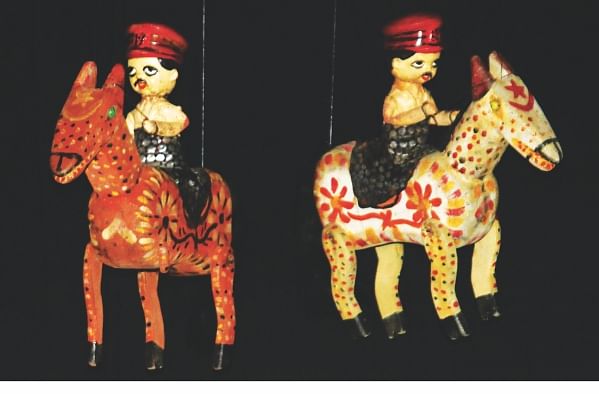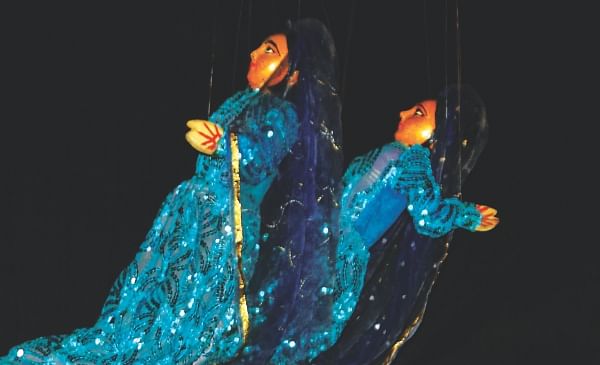One of a Kind
 Each year young students rush to Charukola to enjoy putul nach.
Each year young students rush to Charukola to enjoy putul nach.
The art of puppetry in Bangladesh dates back to at least a thousand years. In the past, certain members of the Hindu community would wander from village to village holding puppet shows. Today, members of the Muslim community are also showing interest in this art. Bharamanbaria was known as the hub of puppet shows. Puppet show is a part of the country's folk culture and tradition, but now it is rarely seen in urban communities. The rural people do get a chance to enjoy puppet shows at least once or twice in a year but the city dwellers hardly have the scope to indulge in this art form.
The tradition of what is commonly known as 'putul naach' is slowly dieing as young people are not encouraged to appreciate this form of art. Also, due to the aggression of electronic media, the artistes are marginalised and the art form is facing extinction. So to shed light on this topic, one must be familiarised with the types of puppets that are common in Bangladesh. According to Banglapedia, the National Encyclopedia of Bangladesh, there are three types of puppets. Wire puppets, stick puppets and tressed puppets, which are made of shola and light wood. They are adorned with cloth and ornaments. Tressed puppets or 'beni putuls' are the ones where two or more puppets are tied and moved together. A skilled puppeteer can manipulate up to three puppets in a go, making them dance or move.
According to the Hindu rural convention, puppet shows were generally about Radha and Krishna or the abduction of Sita. Sometimes, religious stories from the Ramayana and Mahabharata were also depicted by puppeteers. Puppet shows are also about social themes and domestic life. In Bangladesh, puppet shows are mostly staged to represent social awareness. Issues like education, family planning, health and hygiene are brought to the forefront by this medium.
'Putul nach' is an art form which is slowly becoming less popular, yet each year thousands of young people rush to Charukola during Pahela Baishakh (Bengali New Year), to enjoy this one of a kind art. The Pahela Baishakh fair is organised by students of the Faculty of Fine Arts. 'Shonar Bangla' a group of puppeteers have been performing for the last eight years at the institute. “I have been a puppeteer for the last 28 years. Our group which consists of 16 members. We travel from Bikrampur every year to perform at the fair. Our shows are mostly on Rupban, Komolar Bhalobasha, and some of the classical themes from the Bengali Literature. However, this year, the puppet show is based on the Liberation War. It is called 'Ekaturer Pala',” says Mohammad Monir Hossain, one of the oldest members of the group.
 Putul nach depicts various issues of the society.
Putul nach depicts various issues of the society.
The artist Mustafa Monwar also known as the 'puppet man' has played a significant role in the development and modernisation of puppetry in Bangladesh. He runs a centre called the Educational Puppet Development Centre (EPDC) which trains people in puppetry. The EPDC arranges puppet shows taking elements from folk ballads, folk tales and fairy tales. Some of the shows are Pandit O Majhi (The Scholar and the Boatman), Bahurupi (The Clown), Prabad Bakya (Proverbs), Agachha (weeds), Lobh (Greed). Monwar has a weekly slot on state-run Bangladesh Television which has been running since 1965 and is among the channel's most popular programmes.
Monwar's contribution to the art of puppetry in Bangladesh is noteworthy. In an interview, on the lifetime of Mustafa Monwar on 'Priyo-People-Faces of Bangladesh, (an online portal),' Monwar stated that his aim is to spread awareness amongst people. “The literacy rate in Bangladesh is 65 percent and most people do not have access to television, books or newspapers, but puppets can play a role in education, especially for children,” states Monwar.
In the same interview he explains how he moulds the concept of puppetry with social awareness. “I adapt the old village tradition of delivering social messages on integral issues like preventing AIDS through puppet shows. For generations puppets have been used as entertainment,” says Monwar.
Art forms like puppet shows should be preserved. Frequent shows must be held, so that more young people are encouraged to indulge in this rich tradition.

 For all latest news, follow The Daily Star's Google News channel.
For all latest news, follow The Daily Star's Google News channel. 



Comments